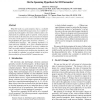91 search results - page 15 / 19 » Representing the Adverb Very in Fuzzy Set Theory |
HICSS
1999
IEEE
13 years 11 months ago
1999
IEEE
What EDI needs is a good semantics, that is, a workable formal theory of what EDI messages mean. As is widely recognized, the point applies to electronic commerce and to communica...
STOC
2002
ACM
14 years 7 months ago
2002
ACM
A string graph is the intersection graph of a set of curves in the plane. Each curve is represented by a vertex, and an edge between two vertices means that the corresponding curv...
KDD
2005
ACM
14 years 7 months ago
2005
ACM
We propose a simple yet potentially very effective way of visualizing trained support vector machines. Nomograms are an established model visualization technique that can graphica...
CIKM
2005
Springer
14 years 28 days ago
2005
Springer
Little work to date in sentiment analysis (classifying texts by ‘positive’ or ‘negative’ orientation) has attempted to use fine-grained semantic distinctions in features ...
ICCS
2007
Springer
14 years 1 months ago
2007
Springer
Abstract. Previous work of the authors has studied a notion of implication between sets of sequences based on the conceptual structure of a Galois lattice, and also a way of repres...



